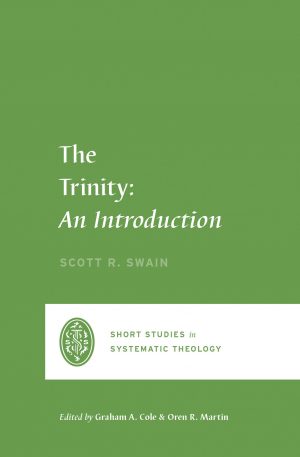The Trinity: An Introduction by Scott R. Swain is the second book in Crossway’s Short Studies in Systematic Theology series. The first was Graham A. Cole’s Faithful Theology: an Introduction. According to series editors, Cole himself and Oren R. Martin, “each volume (1) introduces the doctrine, (2) sets it in context, (3) develops it from Scripture, (4) draws the various threads together, and (5) brings it to bear on the Christian life.”
Unfortunately, The Trinity does not accomplish the first two items in the editors’ list. In my opinion, one cannot understand Trinitarianism, the Christian doctrine of God, without understanding its historical development and creedal/confessional definition. Swain justifies this in terms of space limitations: “The book’s limitations in space and focus mean that it will not give extensive attention to the doctrine’s historical development, polemical uses, or more sophisticated dogmatic elaborations.” Given that this text is explicitly introductory, Swain’s choice to skip those topics—not to mention his editors’ decision to allow it—is difficult to understand.
Fortunately, what The Trinity focuses on is very helpful. Swain focuses on “the basic grammar of scriptural Trinitarianism.” He writes: “If Scripture provides the primary discourse of Trinitarian doctrine, theology is that discipline concerned with understanding and communicating Scripture’s basic grammar so that Christians may become fluent, well-formed readers and speakers of scriptural teaching.” This approach is helpful because the doctrinal definition of Trinitarianism employs terms that are not found in Scripture, terms that clarify what Scripture means and demonstrate is internal coherence. One must understand the interplay of these texts—along with the worship patterns of the early church—in order to understand why Christian theologians employed philosophical terms to define the doctrine. Only by doing so could they show the meaning and coherence of those biblical texts.
Here is the book’s table of contents:
- The Bible and the Trinity: The Basic Grammar
- The Bible and the Trinity: Three Types of Texts
- The Simplicity of God
- God the Father
- God the Son
- God the Holy Spirit
- The Shape of God’s Triune Work
- The End of God’s Triune Work
Although The Trinity describes itself as an introduction, readers need to have at least a passing familiarity with the doctrine and its basic terms before they read the book, or they might feel a bit lost in it. My guess is that the Short Studies in Systematic Theology is directed at Bible college students and seminarians, who are the most likely to consume introductory books on systematic theology. I believe pastors and theologically proficient church leaders and members can also benefit from the book. It will enrich their understanding of why sound biblical theology results in Trinitarianism, and it will help them connect what sometimes seems like an abstract doctrine to the Bible’s core concern, namely, God’s salvation of lost humanity.
Book Reviewed
Scott R. Swain, The Trinity: An Introduction (Wheaton, IL: Crossway, 2020).
P.S. If you liked my review, please click “Helpful” on my Amazon review page.

Leave a reply to retiredpreacher Cancel reply